1.4: Wer bin ich?
( \newcommand{\kernel}{\mathrm{null}\,}\)
Aktivität 14. Wer sind sie?
Watch the „Wer bin ich?” set of video clips and take notes about the native speakers of German. Wie heißen sie? Woher kommen sie? Wie alt sind sie? Was erzählen (tell) sie uns noch?
Berna:
Eva:
Jan:
 |
 |
 |
|
| Name | |||
| Kommt aus | |||
| Alter | |||
| Telefonnummer | |||
| Lieblingsfarbe (warum?) |
You may want to use http://maps.google.de to find out where their home towns are in Germany!
Aktivität 15. Was ist die Antwort?
Listen to Berna’s clip again. Connect the correct questions with the correct answers.
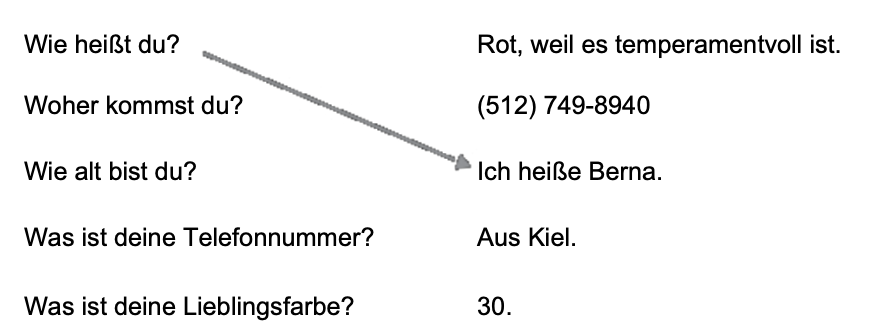
Aktivität 16. Woher kommst due und was ist deine Lieblingsfarbe?
Find out where your two classmates are from and what their favorite colors are and why.
| Name | ||
| Woher kommst due? | ||
| Was ist deine Lieblingsfarbe? | ||
| Warum? |
Woher kommst du?
Ich komme aus _________________________________ (Er/Sie kommt aus …)
Was ist deine Lieblingsfarbe?
Meine Lieblingsfarbe ist __________________ (Seine/Ihre Lieblingsfarbe ist …)
Warum?
_________________ ist meine Lieblingsfarbe, weil es _________________ ist.
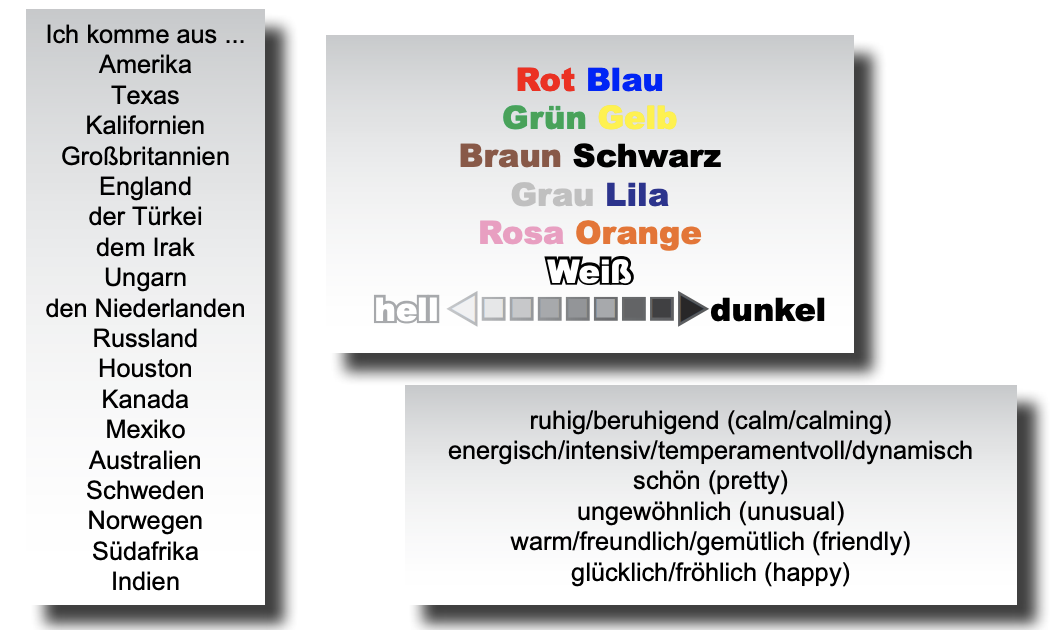
Nota bene: When colors are used as adjectives to describe something, they are not capitalized: Das Haus ist rot.
Aktivität 17. Wer sind die Amerikaner?
Below is a similar table to the one you filled out in Aktivität 13. Go to the Internet site again and watch the „Wer bin ich?” video clips of the American students and fill out the information based on what they say.
Adan:
Hassan:
Erin:
Sara:
Sophia:
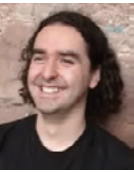 |
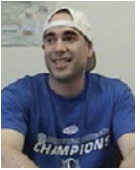 |
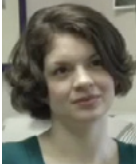 |
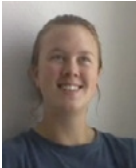 |
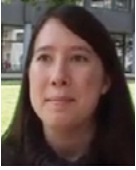 |
|
| Name | |||||
| Herkunft | |||||
| Alter | |||||
| Telefonnummer | |||||
| Lieblingsfarbe (warum?) |
Now, consider the questions posed to both the American and German speakers in Aktivität 13 and 16. What word is used to refer to “you” with these people? ______________________
Consider now your answer to the question as it refered to Harald and Peter in Aktvität 1 and 2. What has changed? How do those two men differ from the people interviewed in Aktivität 13 and 16? Write down your thoughts and discuss them with your classmates.
Aktivität 18. Kurze Beschreibungen
Select any one of the interview subjects (either from the native or the non-native speaker group) and write a brief paragraph that introduces that person. Mention their Name, Herkunft, Alter, Telefonnummer and Lieblingsfarbe.
Er/Sie heißt ________________. ______________ kommt aus ____________________ _________________________________________________________________________ _________________________________________________________________________ _________________________________________________________________________
Aktivität 19. Meine Kommilitonen
Collect the information you jotted down about one of your classmates, and write a paragraph that introduces him or her, using the same information as listed in the previous Aktivitäten.
_________________________________________________________________________ _________________________________________________________________________ _________________________________________________________________________ _________________________________________________________________________
Aktivität 20. Sprache im Kontext: Der Studentenausweiss
Watch the „Sprache im Kontext” clip entitled „Studentenausweis - Student ID” What information you can find on a German University ID according to Mario?
A. Watch the video and check all the words you hear ‰
Name
Universität
Studienfach
Monate
Bibliothek
lesen
Barcode
Studiengang
Vorlesung
ausgehen
offen
Verkehrssystem
B. What purposes does the Studentenausweis serve? Circle the numbers of all the sentences that apply
1. It’s proof of one’s status as student.
2. It lets students take a vacation in Germany.
3. Students can use the public transportation system (for free).
4. It allows students to borrow books from the library.
5. It allows students to find a course of study.
6. It provides information about one’s course of study.
C. Watch the clip again and fill in the blanks with the missing words (they are provided below, out of order).
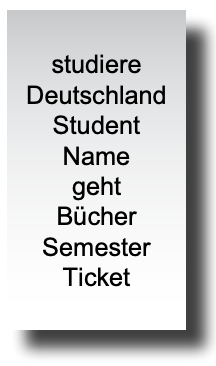
Der Studentenausweis. Damit können wir jedem zeigen, dass wir _______________ sind. Es ist zum Beispiel die Universität vermerkt. Universität Würzburg. Studentenausweis. Und das Semesterticket.
Semesterticket bedeutet, _______________ einfach, ja, es gibt zwei Semester im Jahr und dazwischen jeweils 2 oder 3 Monate Pause in _______________.
Und mit diesem _______________ können wir im öffentlichen Verkehrsnahsystem herumfahren.
Der _______________ ist darauf gemerkt, in dem wievielten Semester ich mich befinde.
Und ein Barcode, damit man in der Bibliothek ___________ ausleihen kann.
Zudem ist vermerkt, welchen Studiengang ich belege und was ich _______________.
Und die Vorlesungsdauer, wie lang eben das Semester _______________ .
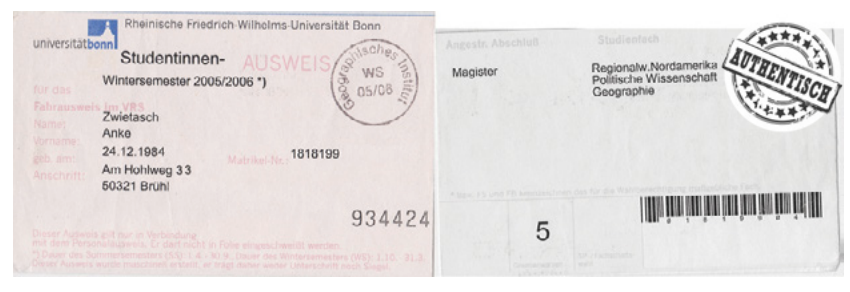
Das ist ein Studentenausweis von einer Studentin. Wie heißt sie? Was ist ihre Matrikelnummer? Was ist eine Matrikelnummer überhaupt? Wann, wo und was hat sie studiert (did she study)?
Aktivität 21. Die Uni Würzburg
Here is an authentic excerpt from the actual registration form for the Julius-Maximilians-Universität in Würzburg. Fill it out according to the prompts, and you are ready to study there next summer! Keep in mind: Germans dates are written differently from American English: Day/ Month/Year (e.g., 10. Mai 2013).

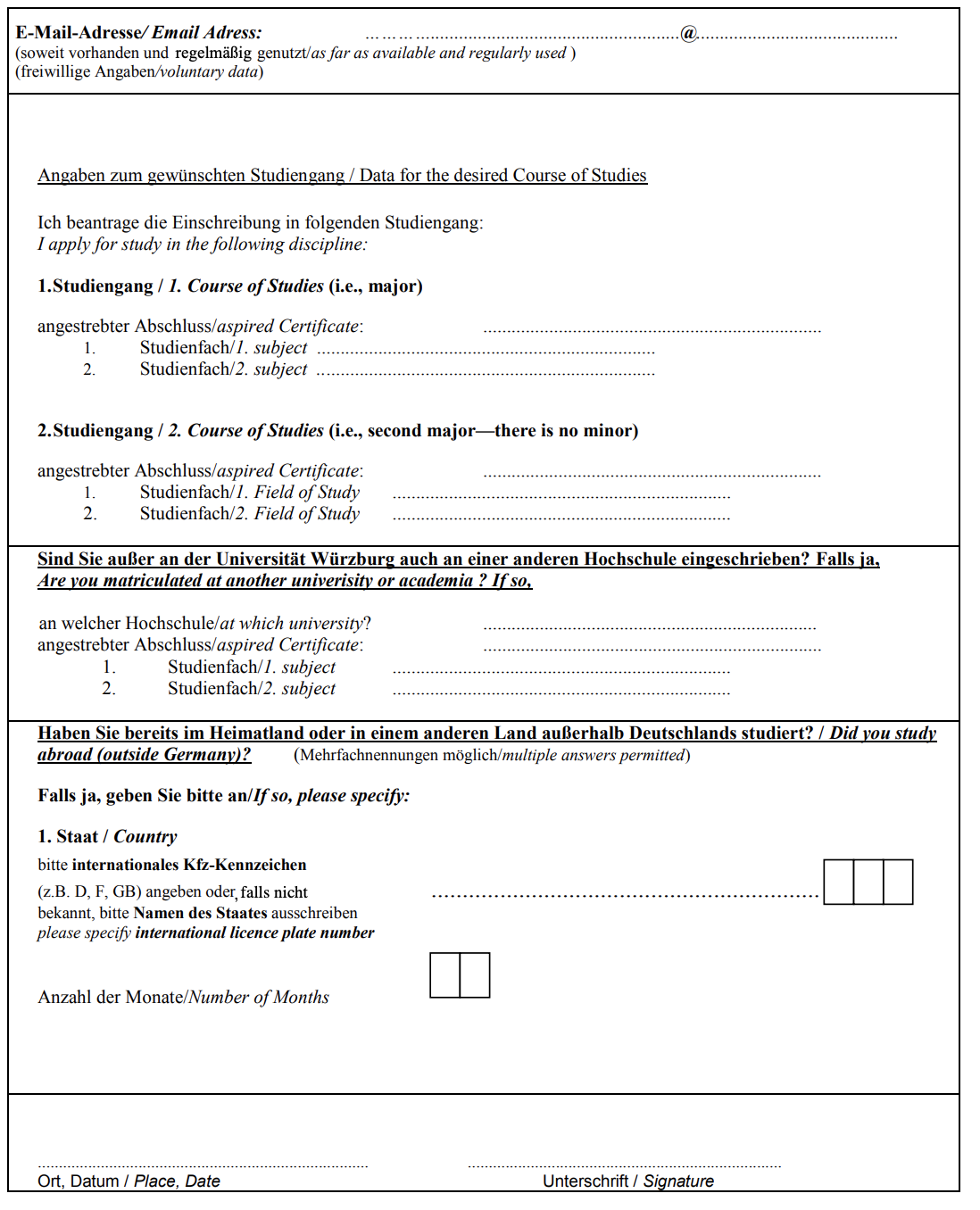

You can explore the other areas of study at Würzburg at http://www.uni-wuerzburg.de/ueber/ fakultaeten/
Aktivität 22. Was machen sie gern?
Listen to the videoclips from Berna, Eva and Jan. The titles of the videos are the column headings in the table. Take notes about what information they give you about themselves. Use the words in the word-bank to help you listen better.
Berna:
Studium & Wohnen:
Freunde & Weiteres:
Eva:
Studium & Wohnen:
Hobbys & Interessen:
Freunde & Weiteres:
Jan:
Studium & Wohnen:
Freunde & Weiteres:

| Studium & Wohnen | Hobbys & Interessen | Freunde & Weiteres | |
 |
|||
 |
|||
 |
Aktivität 23. Ein bisschen Journalismus
Using the notes you took above, try to re-create Eva’s, Berna’s and Jan’s comments. For this exercise, you’ll need to review the regular verbs in the present tense in Grimm Grammar.
 |
|
 |
|
 |
Aktivität 24. Interview
Generate some questions with your classmates that would elicit the kinds of answers the interviewees gave. Select 5-7 questions and conduct an interview with a partner you haven’t worked with yet.
A. Fragen
B. Ein kurzes Interview
| Frage | Antwort |
C. Die Reportage
Write a short paragraph describing your partner’s interests. Feel free to include the previously learned materials regarding his/her name, heritage, studies, etc.
Aktivität 25. Wer macht was?
Watch the „Studium & Wohnen” video clips from Hassan, Erin and Sophia. Then put H, E and/or S next to each statement to indicate who said it.
Hassan:
Erin:
Sophia:
| Ich wohne in der Nähe der Universität. | Ich studierte Philosophie, Altgrieschisch und Latein. | ||
| Ich wohne in der Nähe der Autobahn. | Ich wohne im Europahaus 1. | ||
| Ich studiere Deutsch und Kunstgeschichte. | Jetzt wohne ich in Würzburg. | ||
| In der ersten Woche ist es schwer [in Deutschland] Deutsch zu verstehen. | Ich wohne in Austin. |
Aktivität 26. Erin und Hassan - „Freunde & Weiteres"
Richtig oder falsch? Watch Erin’s and Hassan’s clip „Freunde & Weiteres” and decide which of the following statements are correct, and which are not. Correct those that are false.
A. Erin:
| Ich habe viele deutsche Freunde. | R | F | |
| Ich habe in Würzburg ein Praktikum gemacht. | R | F | |
| In Bayern kann ich Deutsch nicht verstehen. | R | F | |
| Nach ein paar Tagen versteht man viel Deutsch | R | F |
B. Hassan:
| Ich war letzten Sommer in Würzburg. | R | F | |
| Ich habe viele Freunde getroffen. | R | F | |
| Meine Freunde heißen Alfred und Tina | R | F | |
|
Meine Freunde wollen, dass ich ihnen mit ihrem Englisch heife. |
R | F | |
| Es ist leicht in Würzburg Deutsch zu verstehen | R | F |
Aktivität 27. Berna
View Berna’s videos, „Studium & Wohnen” and „Freunde & Weiteres” and find out more about her by answering the following questions.
Studieren & Wohnen:
| What does Berna study at the univerity? | |
| Which languages does Berna know? | |
| In which city does Berna live now? | |
| When did Berna move there? |
Freunde & Weiteres:
| What are Berna's best friends called? | |
| Where are her friends from? | |
| Did she find it difficult to learn English? | |
| How long did she study English in Germany? |
Aktivität 28. Jan
You would like to get to know Berna’s housemate, Jan. Fill in the blanks with the missing information after you watch the following clips of him.
Studieren & Wohnen:
Ich studiere ________________________________________________.
Ich wohne in ______________________, _________________________.
Ich bin im Jahre ______________________________ in Amerika angekommen.
Ich habe hier schon in __________________________________ gelebt und ich habe in Austin gelebt.
Freunde & Weiteres:
Meine besten Freunde in Austin sind ______________________________.
Sie kommen beide aus _________________________________________.
Wir haben schon im deutschen Gymnasium _________________________ gelernt, ab der _______________ten Klasse.
Und ich habe in __________________ auch schon etwas Englisch studiert.
Zum Nachdanken:
In clip 3, Berna emphasizes the word studieren. She says she had English classes at school, then studied English afterwards. Jan also separates learning English in high school and afterwards. First of all, what do you think Schule and Gymnasium refer to? Second, what do you think the word studieren means for German speakers? How is it used differently from the English word to study?
Aktivität 29. Fragen, Fragen, noch mehr Fragen
You learned the question words and a lot of other things that are useful when meeting new people. You are participating in the exchange program with Würzburg. With a partner collect keywords that can help you generate questions to ask people you meet in your courses.
A. Keywords for personal questions
| Beispiel: Herkunft | ||
| Woher? | ||
B. Generate questions using question words and the keywords above.
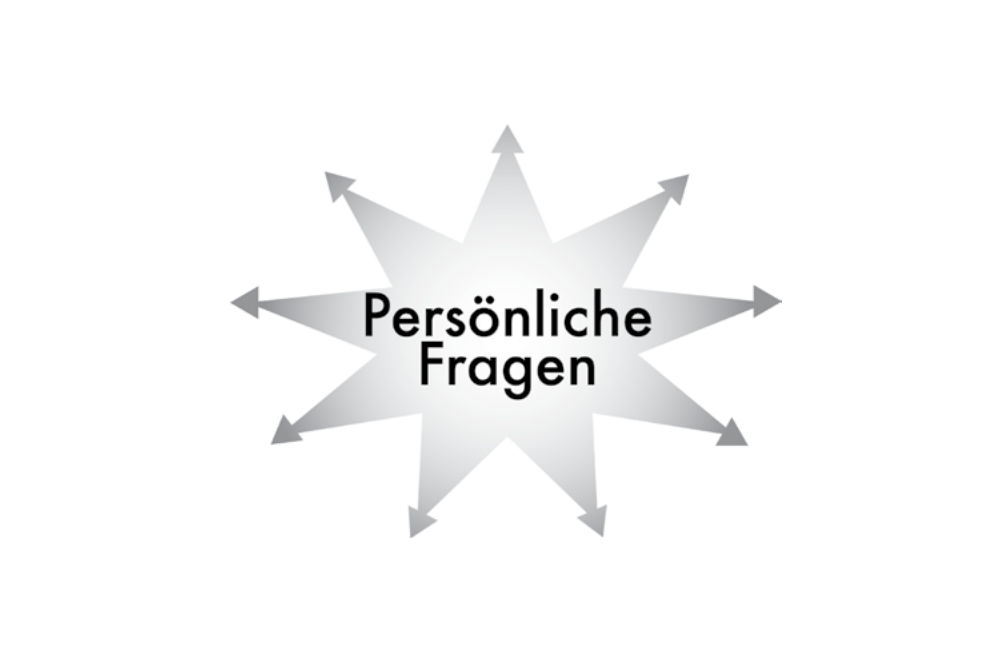
C. Interview one of your classmates using some of the questions you generated.
Jot down their answers and then write a short report about their answers. Present your report to the class.
Aktivität 30. Sprache im Kontext: Das Handy
Now that you got to know new people in Würzburg you need a way to contact them. Therefore, one of the first things you will need (ok, want) to buy right away in Würzburg is a Handy. Listen to Adam to learn what a Handy actually is (since you will want it so soon, you might as well find out what it is!), how to get it, and what phrases you will need to be able to purchase it.
A. Watch the „Sprache im Kontext” clip with Adam and and write down what the clip is about:
What do you notice? Who is in the video? Where does it take place? What do you think is it about?
B. Watch the clip again, jot down all the words you recognize:
C. Watch the clip a third time, and figure out what a Handy is: _________________
D. When you watch the clip the fourth time, answer these more detailed questions:
| What is the name of the Handy-store? | What is the special offer? | ||
| What kind of a Konto does he recommend opening? | How much does it cost to use the Handy in Germany? | ||
| What kind of Handy can you buy? | How much does it cost when someone calls you? | ||
| How much is a Handy without a SIM-Karte? | How much is it to send and receive an SMS? |
E. Watch the clip one more time and bring the following statements in the right order:
_____ Der Verkäufer kann das Geld auf Ihr Handy laden.
_____ Sie bekommen eine Karte mit einem PIN-Code darauf.
_____ Sie bezahlen 30 Euro.
_____ Sie sagen: „Ich brauche 30 Euro Guthaben, bitte.”
Aktivität 31. Lieder & Musik
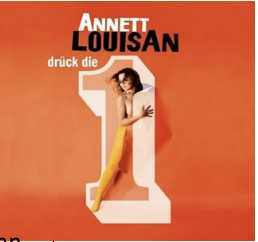
To introduce the song and to learn about the artist, go to Annett Louisan’s website at http://www.annettlouisan.de. Here is the song and music video for „Drück die Eins".
1. Vor dem Hören/Sehen (before listening/watching)
a. Wer ist Annett Louisan? Woher kommt sie? Wie alt ist sie? (Who is A.L.? Where is she from? How old is she?) _________________________________________________________________________________________
b. Was könnte der Titel von dem Lied bedeuten? (What could the title mean?) _________________________________________________________________________________________
2. Beim Sehen (when watching)
a. Ohne Musik! (without music)
Sehen Sie sich das Video ohne Musik an. Was fällt Ihnen auf? Wer ist in dem Video? Wo spielt es? Worum geht es? (Watch the video without sound. What do you notice? Who is in the video? Where does it take place? What is the story?)
_________________________________________________________________________________________ _________________________________________________________________________________________ _________________________________________________________________________________________ _________________________________________________________________________________________
b. Wie finden Sie das Video? (How do you like the song?)
orginell - monoton - modern - altmodisch - experimentell - poetisch - romantisch – interessant – komisch – doof – langweilig – “anders” – spannend – schrecklich
c. Wie ist die Stimmung (mood)?
glücklich - traurig - neutral - melancholisch - romantisch - kalt - aggressiv - depressiv – sentimental – laut – energisch – verträumt – warm – harmonisch – chaotisch – ruhig
3. Beim Hören (While watching/listening)
a. Sehen und hören Sie sich das Video jetzt mit Musik an. (Now watch and listen to the video with music)
Welche Nummern soll man drücken? (What buttons should the caller press?)

4. Nach dem Hören/Sehen (after watching)
a. Hören Sie sich das Lied noch einmal an, und füllen Sie die Lücken mit den folgenden Substantiven und Pronomen aus. (Listen to the song again and fill in the blanks with the following substantives and pronouns.)

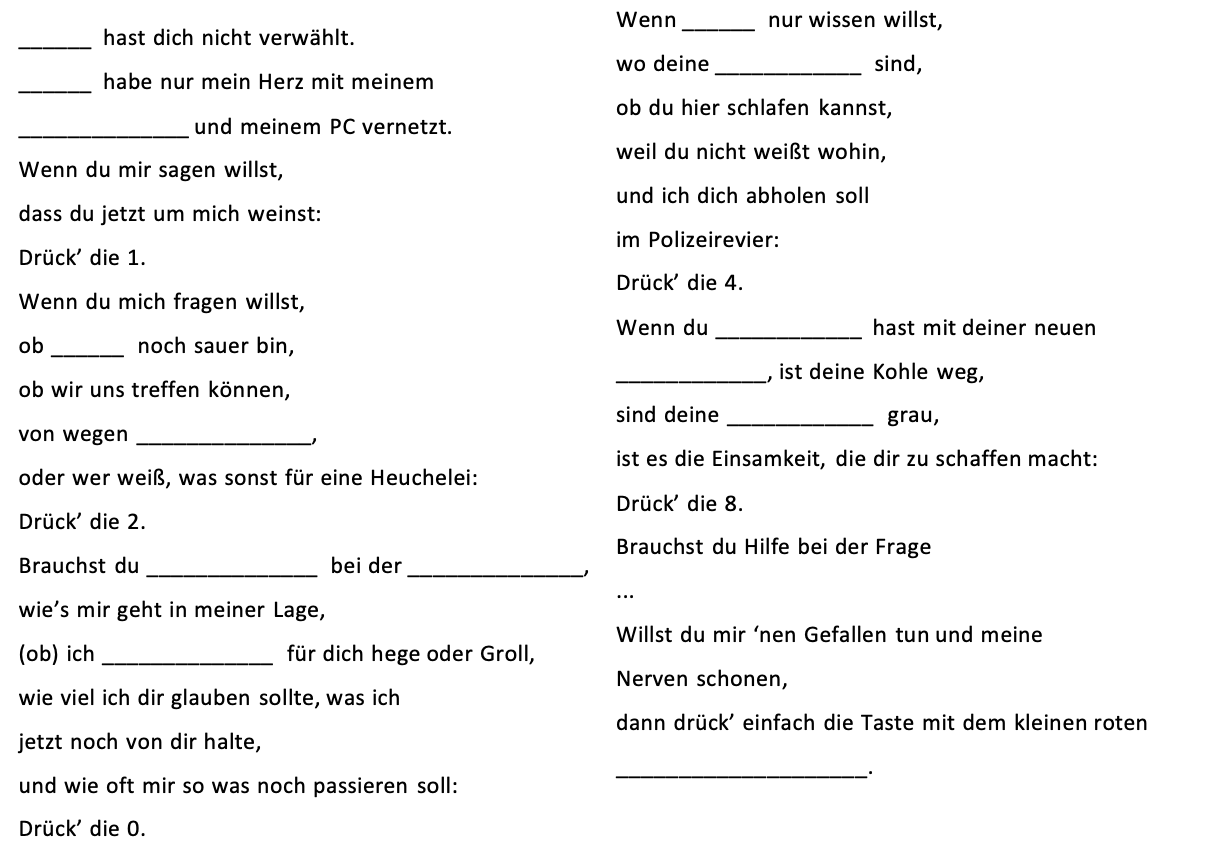
b. Welche Note gibst du dem Song? (What grade would you give the song?) ______
Aktivität 32. Sprechen Sie Deutsch?
Aktivität 32. Sprechen Sie Deutsch? You already learned different greetings throughout the chapter, but there are many other forms depending where you are. The following text describes the different greetings used in the German speaking countries on the European continent. Read the text below and answer the questions.
In Deutschland, Österreich und der Schweiz sprechen die Menschen zwar alle Deutsch, aber es hört sich teilweise ganz unterschiedlich an. In dem Text lernen Sie, wie man sich in den drei Ländern begrüßt und verabschiedet.
In den deutschsprachigen Ländern hört man verschiedene Dialekte. In Norddeutschland zum Beispiel spricht man Plattdütsch und begrüßt sich mit „Moin moin”. Im Süden (zum Beispiel in Bayern oder in BadenWürttemberg) sagen die Menschen „Grüß Gott”, wenn sie andere Leute treffen. In Deutschland spricht man auch Hochdeutsch und benutzt Begrüßungsformeln wie „Guten Morgen”, „Guten Tag” oder „Guten Abend”. In Österreich hören wir auch „Servus” und „Grüß dich”. In der Schweiz hört man „Grüezi“ (Grüß Sie). Die hochdeutschen Begrüßungen und die Verabschiedung „Auf Wiedersehen” versteht man natürlich auch in der Schweiz.
Wichtig ist auch, dass man unbekannte oder fremde Leute mit „Sie“ anspricht (siezen). Normalerweise spricht man nur gute Freunde oder Familienmitglieder mit „du“ an (duzen). Freunde begrüßen sich mit „Hallo“, „Hi“ oder in Bayern auch „Servus“. Zur Verabschiedung sagt man unter Freunden „Tschüss“, „Mach’s gut“ oder „Ciao“. Speziell in Mittel- und Norddeutschland sagt man „Tschüss“ und im Rheinland „Tschö“. Standarddeutsch für Verabschiedungen ist „Auf Wiedersehen“. In Baden-Württemberg sagt man zur Verabschiedung „Ade“.
Fragen zum Text
1. Write down all the greetings for the three countries: which terms are used for greeting and taking leave?
| Deutschland | Österreich | Die Schweiz | |||
| Begrüßung | Verabschiedung | Begrüßung | Verabschiedung | Begrüßung | Verabschiedung |
2. According to the text which of these greetings are formal and which are informal?
3. How do you understand „duzen” and „siezen” based on this text? With whom do you think you would use each of these? Is there any similar distinction in formality in your own language?
4. Do you have German-speaking family or friends? If yes, find out from them, what greetings they use with various people (either in writing or in spoken interactions).
Aktivität 33. Kennenlernspiel
In this chapter you learned how to introduce yourself and get to know others. You already talked to a couple of your peers during this chapter, and now it’s time to get to know everyone else in class as well.
First, write three questions that you would need in order to find the information the boxes ask for. Try the rest as you go. Remember, instead of using a question word simply use and conjugate the verb of the sentence. Place it in the very beginning (the place a question word would have taken) of the sentence. Tada! Some of the verbs might look strange, those are irregular forms, just recognize it for now.
For example:
„Reist du in die Schweiz?”
• _________________________________________________________
• _________________________________________________________
• _________________________________________________________
Then, talk to your classmates. Ask the questions and write down the student’s name who can answer each question with ”yes“.
Finde mindestens eine Person, die …




